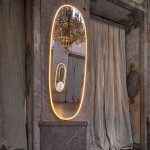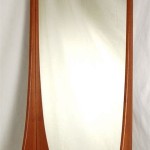Antiqued Mirror Room Divider Screen: An Elegant and Functional Addition to Interiors
The antiqued mirror room divider screen represents a sophisticated and practical solution for partitioning space, adding visual interest, and enhancing the overall aesthetic of a room. It combines the functionality of a traditional room divider with the reflective qualities and vintage charm of antiqued mirrors, creating a unique and versatile design element. This article explores the features, benefits, design considerations, and applications of antiqued mirror room divider screens, providing a comprehensive understanding of their role in interior design.
Features of Antiqued Mirror Room Divider Screens
Antiqued mirror room divider screens are defined by several key characteristics that contribute to their distinct appeal and utility. These features involve the materials used, the construction methods employed, and the specific techniques applied to achieve the desired aesthetic.
Mirror Paneling: The most prominent feature of these screens is the inclusion of antiqued mirror panels. These panels are typically made of glass that has been treated to create a weathered or aged appearance. The antiquing process involves several techniques, such as applying acid etching, silvering solutions, or specialized paints to mimic the oxidation and wear associated with old mirrors. This results in a surface with subtle imperfections, spots, and variations in tone, lending each panel a unique and characterful look. The size and arrangement of the mirror panels can vary depending on the design, ranging from large, single mirrors covering entire sections to smaller, geometrically arranged mirrors creating a mosaic-like effect.
Frame Construction: The frame of the room divider is crucial for structural integrity and aesthetic integration. Common frame materials include wood, metal, and composite materials. Wood frames, particularly those made from hardwoods like oak, maple, or mahogany, provide a classic and warm appearance. They can be stained, painted, or left natural to complement the surrounding décor. Metal frames, often constructed from steel or wrought iron, offer a more contemporary or industrial aesthetic. They are typically powder-coated to prevent rust and can be finished in various colors. Composite materials, such as MDF (Medium Density Fiberboard), provide a cost-effective alternative and can be easily shaped and finished. The frame design can range from simple and minimalist to ornate and decorative, depending on the desired style.
Panel Configuration: Room divider screens are typically constructed with multiple panels that are hinged together, allowing them to be folded and positioned in various configurations. The number of panels can vary, with three-panel and four-panel screens being the most common. The hinges connecting the panels are usually designed to allow for 360-degree rotation, providing flexibility in how the screen is arranged. Some screens may also incorporate locking mechanisms or support feet to enhance stability, particularly on uneven surfaces. The height and width of the panels are important considerations, as they determine the overall size of the screen and its effectiveness in partitioning space. Taller screens provide greater privacy, while wider screens can divide larger areas.
Finishing and Embellishments: The finishing touches on an antiqued mirror room divider screen can significantly impact its overall appearance. The frame may be adorned with decorative moldings, carvings, or other embellishments to enhance its visual appeal. The mirror panels themselves may feature beveled edges or etched designs to add further detail. Hardware, such as hinges and handles, can also be chosen to complement the overall design. For example, antique brass or wrought iron hardware can enhance a vintage or rustic aesthetic, while sleek chrome or stainless steel hardware can contribute to a more contemporary look.
Benefits of Using Antiqued Mirror Room Divider Screens
The use of antiqued mirror room divider screens offers numerous benefits, extending beyond their basic function of partitioning space. These advantages encompass aesthetic enhancement, functional utility, and practical considerations.
Space Partitioning and Privacy: The primary function of a room divider screen is to create separate zones within a larger space. Antiqued mirror screens can effectively delineate areas for different purposes, such as creating a reading nook in a living room, separating a home office from a bedroom, or providing privacy in a shared space. The reflective surfaces of the mirrors can create an illusion of greater space, an asset when adding privacy to smaller rooms. By strategically positioning the screen, it is possible to block direct views and create a sense of seclusion without completely enclosing the area. This is especially useful in open-plan layouts where the need for defined spaces arises.
Aesthetic Enhancement and Visual Appeal: Antiqued mirror room divider screens serve as decorative elements, adding character and visual interest to a room. The aged appearance of the mirrors lends a vintage or rustic charm, contributing to a warm and inviting atmosphere. The reflective surfaces can also brighten a space by reflecting natural and artificial light, creating a more luminous and airy feel. The decorative details of the frame, such as moldings, carvings, and hardware, further enhance the screen's aesthetic appeal. These screens can serve as focal points in a room, drawing attention and adding a touch of elegance.
Flexibility and Portability: Unlike permanent walls or partitions, room divider screens offer flexibility in arranging and reconfiguring space. They can be easily moved and repositioned as needed, allowing for adaptable room layouts. This is particularly useful in situations where space requirements change over time, such as when a home office needs to be temporarily set up or when additional privacy is required for guests. The portability of the screens also makes them suitable for rental properties or temporary living situations where permanent alterations are not possible. Additionally, they are easy to store when not in use, taking up minimal space when folded flat.
Light Reflection and Amplification: The reflective properties of mirrors can significantly impact the perceived brightness and spaciousness of a room. Antiqued mirror screens can bounce light around the space, illuminating darker corners and creating a more open and airy atmosphere. This is particularly beneficial in rooms with limited natural light or in areas where additional illumination is desired. The antiqued finish of the mirrors softens the reflection, creating a subtle and diffused light that is less harsh than that of a standard mirror. This can contribute to a more comfortable and inviting ambiance.
Concealing Unsightly Areas: Room divider screens can be used to conceal unsightly areas or elements in a room, such as storage shelves, messy corners, or exposed wiring. By strategically positioning the screen, it is possible to block these elements from view, creating a more organized and aesthetically pleasing space. This can be particularly useful in small apartments or homes where storage space is limited and clutter is a common issue. The screen can also serve as a backdrop for decorative elements, such as plants or artwork, further enhancing the overall aesthetic of the room.
Design Considerations for Antiqued Mirror Room Divider Screens
Incorporating an antiqued mirror room divider screen into interior design requires careful consideration of several factors, including the style of the room, the size and layout of the space, and the desired level of privacy and functionality. These considerations ensure that the screen seamlessly integrates into the design scheme and effectively serves its intended purpose.
Style Compatibility: The style of the room divider screen should align with the overall design aesthetic of the space. For a traditional or vintage-inspired room, a screen with an ornate wooden frame and heavily antiqued mirror panels would be appropriate. In a contemporary or minimalist setting, a screen with a sleek metal frame and subtly antiqued mirrors would be more suitable. The color and finish of the frame should also complement the existing décor, whether it be matching the wall color, coordinating with the furniture, or providing a contrasting accent. The goal is to create a cohesive and harmonious look that enhances the overall aesthetic of the room.
Size and Scale: The size of the room divider screen should be proportionate to the size of the space it is intended to divide. A large screen in a small room can feel overwhelming, while a small screen in a large room may not be effective in providing adequate privacy or partitioning. The height of the screen should also be considered, as taller screens provide greater privacy and visual separation. The width of the screen should be sufficient to cover the area that needs to be divided or concealed. It is important to measure the space carefully and choose a screen that fits comfortably without obstructing traffic flow or making the room feel cramped.
Placement and Positioning: The placement of the room divider screen is crucial for maximizing its functionality and aesthetic impact. Consider the natural and artificial light sources in the room and position the screen to best reflect and amplify the light. Avoid placing the screen in areas where it will block doorways or create obstacles. Experiment with different arrangements to determine the optimal positioning for privacy, space partitioning, and visual appeal. Consider the angle at which the screen is placed, as this can affect the amount of privacy it provides and the way it reflects light.
Functionality and Purpose: The intended purpose of the room divider screen should guide the design choices. If the primary goal is to provide privacy, a taller and wider screen may be necessary. If the goal is to simply define different zones within a room, a shorter or narrower screen may suffice. Consider whether the screen needs to be easily moved or repositioned on a regular basis. If so, choose a lightweight screen with smooth-rolling casters. If stability is a concern, opt for a screen with locking mechanisms or support feet. The functionality of the screen should be prioritized to ensure that it meets the specific needs of the space.
Material and Durability: The materials used in the construction of the room divider screen should be durable and long-lasting. Wood frames should be made from high-quality hardwoods that are resistant to warping and cracking. Metal frames should be powder-coated to prevent rust and corrosion. The mirror panels should be made from tempered glass for added safety and resistance to breakage. Consider the level of maintenance required for different materials. Wood frames may need to be periodically cleaned and polished, while metal frames may only require occasional dusting. Choose materials that are appropriate for the intended use and environment.

Antique Mirrors Mirror Room Divider Mirrored Furniture Decor

Arteriors Home Stephan Antique Mirror Room Screen

Extraordinary And Important Four Panel Antique Mirrored Screen For At 1stdibs Vintage Mirror Room Divider
More Mirrors Custom Made Mirrored Screen Room Divider Casa Victoria Vintage Furniture On Los Angeles Sunset Boulevard

Tall Vintage Mirrored Room Divider For At 1stdibs Mirror Dividers Screen

Antique Mirrored Screen Mirror House Vintage Mirrors Room Divider

Buy Vintage 70s Mirrored Three Panel Folding Screen Or Room Divider By Ello In

Arteriors Home Stephan Antique Mirror Room Screen

Mirrored Room Divider Foter Fabric Dividers Walls Wooden

Arched Window Mirror Divider Screen Antique Farmhouse








